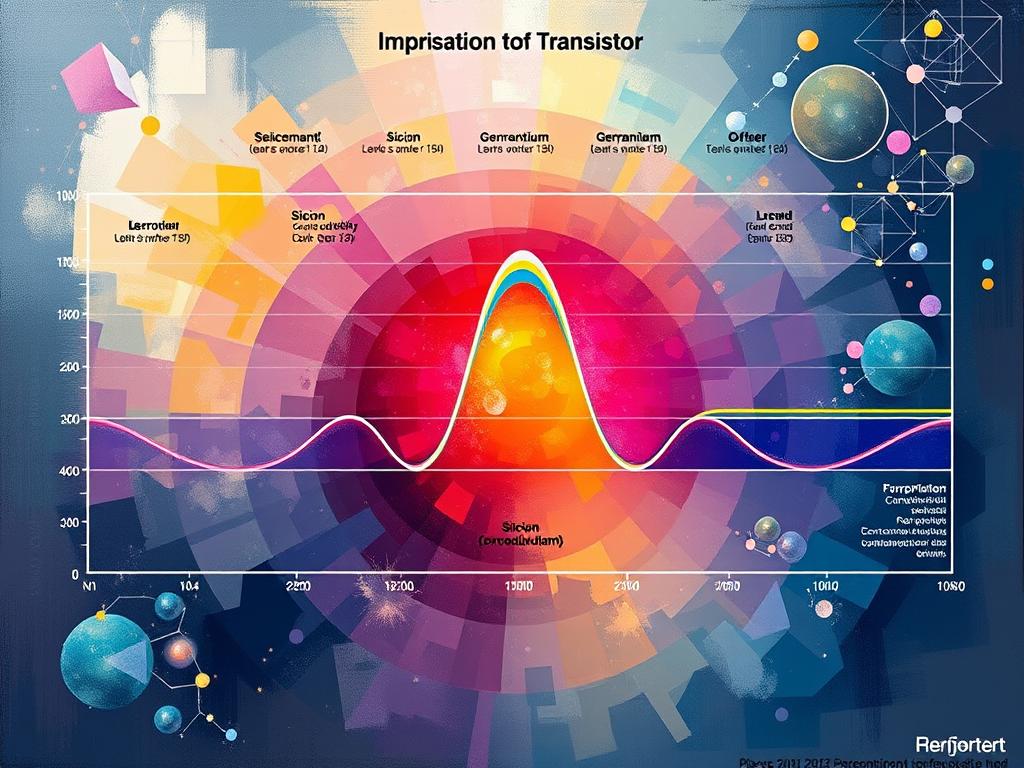Threshold voltage is crucial for creating a 2D electron gas in field-effect transistors. Energy band diagrams help us understand this and other aspects of electron flow. These visual tools are vital for engineers working with electronic devices.
Energy band diagrams show the electronic structure of materials. They display conduction and valence bands, along with the Fermi level. These diagrams help us grasp how electrons move within semiconductor devices.
The Fermi-Dirac distribution is key to understanding carrier distribution in these diagrams. The zeroth-order Fermi-Dirac integral, F0(⌘) = ln[1 + exp(⌘)], provides insights into electron behavior. This information is valuable for semiconductor materials research.
Energy band diagrams help visualize complex concepts in semiconductors. They show sub-threshold characteristics and built-in potentials in PN junctions. These diagrams have practical uses in designing better electronic devices.
Understanding Energy Band Diagrams in Electronics
Energy band diagrams are vital for grasping electron behavior in electronic materials. These visual tools help experts understand semiconductor physics. They aid in designing better electronic devices.
What Are Energy Band Diagrams?
Energy band diagrams show allowed energy states for electrons in materials. They display two key bands: valence and conduction. The space between these is the bandgap energy.
The valence band represents the outermost electron shell in atoms. The conduction band allows electrons to move freely, enabling electrical conductivity. Bandgap energy determines a material’s electrical properties.
- Insulators: Large bandgap (> 4 eV)
- Semiconductors: Moderate bandgap (1-3 eV)
- Conductors: Overlapping bands or tiny bandgap
How Do Energy Bands Affect Electron Flow?
Energy bands greatly influence electron flow in materials. In semiconductors, electrons can jump to the conduction band with enough energy. This creates electron-hole pairs, allowing current to flow.
The Fermi level represents the highest occupied electron energy at absolute zero. It predicts electron movement between bands and affects a material’s conductivity.
“Understanding energy band diagrams is essential for electronic devices such as diodes and transistors.”
Engineers control electron flow by altering energy levels through doping or applying voltages. This manipulation enables the creation of transistor channels and other semiconductor devices.
These techniques have paved the way for modern electronics. They’ve revolutionized how we design and use electronic components. Semiconductor physics continues to drive innovation in the field.
The Importance of Energy Band Diagrams in Transistors
Energy band diagrams are key to grasping transistor function. They help experts understand electron behavior in semiconductors. These visual tools are crucial in electronics.
Role in Semiconductor Physics
Energy band diagrams show electron movement in transistor channels. They display valence and conduction bands, essential for understanding electrical conductivity. Silicon’s bands explain its usefulness in electronic devices.

These diagrams reveal doping’s effects on semiconductors. Doping adds impurities that alter electrical properties. By visualizing these changes, experts can improve transistor performance.
Impact on Device Performance
Energy band knowledge is vital for optimizing transistors. The diagrams show how voltage and temperature affect carrier mobility. This insight helps create faster, more efficient electronics.
These diagrams also tackle modern electronics challenges. They help navigate quantum effects in smaller devices. This leads to breakthroughs in quantum computing and nanotechnology.
| Aspect | Importance |
|---|---|
| Electron flow | Visualizes movement in transistor channels |
| Doping effects | Shows impact on electrical properties |
| Device optimization | Guides performance improvements |
| Quantum effects | Helps address challenges in small-scale devices |
Visual Representation: Interpreting Energy Band Diagrams
Energy band diagrams show electron behavior in semiconductor devices. They help engineers understand complex concepts like Fermi level and band bending. These visual tools are crucial for designing advanced electronics.
Key Components of Energy Band Diagrams
Energy band diagrams consist of several crucial elements:
- Conduction band: The energy level where electrons can move freely
- Valence band: The highest energy band filled with electrons at absolute zero
- Fermi level: The energy at which the probability of electron occupation is 50%
- Bandgap: The energy difference between the conduction and valence bands
Reading the Diagram: A Step-by-Step Guide
To interpret an energy band diagram:
- Identify the conduction and valence bands
- Locate the Fermi level
- Observe any band bending, which indicates changes in electric potential
- Look for depletion regions, where mobile charge carriers are absent
- Check for inversion layers, where minority carriers become the majority
Understanding these parts helps engineers improve transistor performance. Silicon’s bandgap is 1.1eV, while germanium’s is 0.72eV. These differences affect electron behavior and device features.
Mastering energy band diagrams allows better semiconductor device design. This knowledge leads to more efficient and powerful electronics. Engineers can create innovative solutions with this visual tool.
Practical Applications of Energy Band Diagrams
Energy band diagrams are vital tools in technology. They help engineers and scientists improve device performance. These visual aids also assist in developing new technologies.
In Electronics Design
Electronics designers use energy band diagrams to enhance semiconductor devices. These diagrams show how electrons move through different materials. In GaN transistors, they reveal how wide bandgaps lead to high-power efficiency.
In Renewable Energy Technologies
Energy band diagrams are crucial for solar cell development. They help scientists design more efficient photovoltaic devices. By optimizing semiconductor layers’ band gaps, solar cells can capture more light.
In Emerging Semiconductor Technologies
Energy band diagrams guide the development of new materials and devices. They’re key in designing quantum wells and heterojunctions. These components are essential in LEDs and advanced electronic devices.
| Material | Band Gap (eV) | Application |
|---|---|---|
| Germanium (Ge) | 0.72 | Infrared sensors |
| Silicon (Si) | 1.1 | Solar cells, transistors |
| Gallium Arsenide (GaAs) | 1.42 | LEDs, high-speed circuits |

These diagrams help create more efficient devices, from everyday electronics to advanced energy systems. Their role in shaping our electronic future continues to grow.
Common Misconceptions About Energy Band Diagrams
Energy band theory is key to understanding semiconductor properties. However, misconceptions about energy band diagrams can lead to wrong ideas about electron behavior. These errors can affect how we interpret transistor channels.
Dispelling Myths
Many think energy is released when breaking chemical bonds. Actually, energy is absorbed during bond breakage. Energy is released when new bonds form.
This mistake can greatly impact how engineers design semiconductors. Another error is oversimplifying electron behavior in energy band diagrams.
Some believe higher temperatures lower activation energy. This isn’t true. Catalysts, not temperature, lower energy barriers in semiconductor processes.
Understanding Real-World Implications
Misreading energy band diagrams can cause errors in device modeling. For example, a diode’s voltage at thermal equilibrium relates to the semiconductor’s bandgap voltage. This rule doesn’t apply to heterojunctions or Schottky diodes.
This knowledge is crucial for accurate transistor channel analysis. The Fermi level concept often confuses people. In semiconductors, it’s usually midway through the bandgap.
The Fermi level increases with bandgap voltage. This info is vital for predicting electron flow in transistor circuits.
| Misconception | Reality | Implication |
|---|---|---|
| Energy released when breaking bonds | Energy absorbed to break bonds | Affects semiconductor design approach |
| Temperature lowers activation energy | Catalysts lower energy barriers | Impacts process optimization strategies |
| Fermi level location arbitrary | Fermi level midway through bandgap | Crucial for accurate electron flow prediction |
Understanding these facts helps engineers make better choices in semiconductor device development. This knowledge leads to more efficient and reliable transistor designs.
Long-Tail Keywords Related to Energy Band Diagrams
Energy band diagrams are key to understanding semiconductor physics. These diagrams help us grasp the complex behavior of electrons in materials. Let’s explore some important concepts related to energy band diagrams.
Energy Band Theory in Transistors
Energy band theory explains electron behavior in transistors. It focuses on energy band alignment and carrier transport. These concepts are crucial for designing efficient electronic devices.
Transistors work by moving charge carriers through different energy levels. The band gap is the energy difference between valence and conduction bands. This gap greatly affects a transistor’s performance.
| Material | Band Gap (eV) | Carrier Mobility (cm²/V·s) |
|---|---|---|
| Monolayer InSe | 2.4 | 1000-2000 |
| Black Phosphorus | 0.3-2.0 | ~1000 |
| GaSe | 2.0 | 1000-2000 |
Energy Band Gap and Its Significance
The energy band gap determines a material’s electrical properties. It affects quantum confinement and influences electron movement within semiconductors. For example, monolayer InSe has a band gap of 2.4 eV.
These concepts help engineers design better transistors. By adjusting energy band alignment, researchers can create more efficient electronic components. Understanding quantum confinement also leads to improved device performance.
Frequently Asked Questions About Energy Band Diagrams
Energy band diagrams are vital in semiconductor engineering and device physics. They help us understand how materials behave electrically. Let’s explore some common questions about these useful tools.
How Do Energy Bands Influence Electrical Conductivity?
Energy bands greatly affect electrical conductivity in materials. The band gap size determines electron movement between valence and conduction bands. Smaller gaps allow easier electron flow.
| Material Type | Band Gap (eV) | Conductivity |
|---|---|---|
| Conductors (e.g., Gold, Copper) | 0 | High |
| Semiconductors (e.g., Silicon) | 1.1 | Moderate |
| Insulators (e.g., Glass) | Up to 7 | Low |
Conductors have no band gap, allowing easy electron flow. Semiconductors have a small gap, enabling controlled conductivity. Insulators have large gaps, restricting electron movement.
Why Are Energy Band Diagrams Important for Engineers?
Energy band diagrams are crucial for semiconductor device design. They help engineers visualize material behavior under different conditions. These tools aid in optimizing device performance.
- Optimize device performance
- Design new semiconductor materials
- Troubleshoot electrical issues
Understanding energy bands helps create better electronic devices. This knowledge advances technologies in computing, communications, and renewable energy. Engineers use these diagrams to solve complex problems.
Semiconductor engineering relies heavily on energy band diagrams. They help push the limits of electronic design. These tools drive innovation in the tech industry.
Future Trends in Energy Band Diagram Research
Energy band diagram research is evolving fast. New tech and methods are expanding our understanding. Quantum computing and nanotechnology demand more advanced analysis tools.
Innovations in Simulation Techniques
Advanced simulation techniques are changing energy band structure studies. They model complex semiconductor structures with high accuracy. Researchers can now simulate materials like germanium and silicon under various conditions.
This precision is key for developing new electronic devices. It helps understand materials with different forbidden gaps, such as germanium (0.72eV) and silicon (1.1eV).
The Role of AI in Energy Band Analysis
AI is transforming semiconductor design and analysis. It processes huge amounts of data, finding patterns in band structures of new materials. This helps with complex compounds where crystal potential varies.
AI quickly analyzes E-k diagrams and calculates electron affinity. This speeds up innovation in the field. It’s especially useful for heterostructures and advanced materials.
AI in semiconductor design opens new doors in quantum computing and nanotech. It may lead to more efficient devices. We could better understand drift efficiency and E0 variation.
The future of energy band diagram research is bright. Breakthroughs could reshape our tech landscape. We’re on the brink of exciting discoveries in this field.


